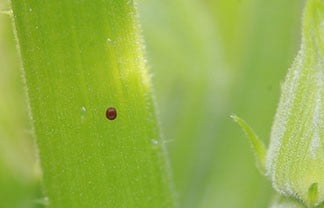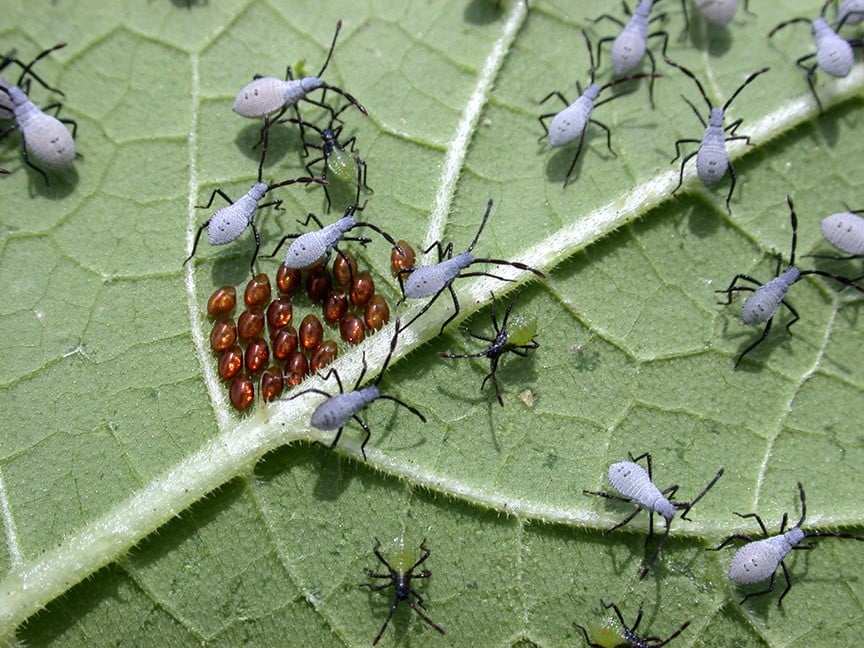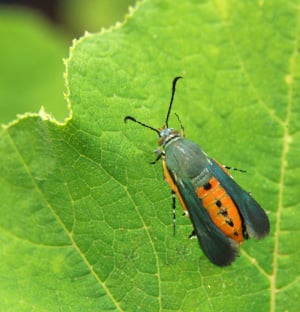Squash bugs and Squash Vine borers can be difficult pests to get rid of in your garden. Stepping into the garden and finding an entire beautiful squash plant completely wilted and laying on the ground is totally disheartening.

So much so that many gardeners in my area won’t grow cucurbits at all. It’s difficult to keep up with all the eggs and damage and it’s heartbreaking to see all of your hard work destroyed in a few hours.
Squash bugs and Squash Vine Borer eggs are best discovered and dealt with early to prevent losing an entire crop. Both of these are laid by adult pests and can be identified easily if you have all the information we provide below.
Identifying the Eggs
Squash Vine Borer Eggs

The eggs of female squash vine borer moths are tiny, flat, and oval-shaped brown eggs. They can be seen by the naked eye.
The eggs are laid separately and singly. This is one way you can be sure if the eggs are squash vine borer eggs.
Squash Bug Eggs

Squash bugs lay eggs in groups and all the eggs are found in clusters. These are either brick red or bronze in color and can be easily found on the underside of the leaves in clusters.
You Might Also Like: Squash Vine Borer: How To Prevent, Protect, And Get Rid Of Them

Egg Laying Season
Squash Vine Borer Eggs
The adult squash borers come out sometime near the last week of June from their cocoons and lay eggs on your cucurbit plants.

The eggs hatch in 6-8 days, and the larva comes out of the egg, burrows directly into the plant, and begins eating it’s way through the plant until it’s done and then it drops down in the soil until it emerges the next year.

Not all areas of the country have Squash Vine Borers. Some areas see them one time a year between June and the first of July – other areas see them straight through until October – like my area :/. The Pacific Coast doesn’t have them and the southern states have 2 generations a year.
Check with your local county extension to see if these are a pest in your area and how many generations you’ll see each year and when.
Squash Bug Eggs
Once the Squash bugs start laying eggs (from early June to the mid-summer), they hatch in 5-10 days on average and come out with a whitish powder on them.
Squash bug eggs can be found on underside of the leaves, between the veins of the leaf. These eggs can also found on the stem of the plants.
The 2nd generation of Squash bugs overwinter and start producing eggs in the following year.
Right After Squash Vine Borer Eggs are Hatched
Squash Vine Borer Larvae

In around week, the eggs hatch and larvae comes out of the egg. The hatched squash vines borer larvae bore into the stem of the squash plant by making a small hole in the main stem and can remain there for about more than a month eating through the plant.
During this time the larva makes its way to and feeds on the center stem of the plant making it impossible for water and minerals to go through the stem to the rest of the plant.
Once it reaches the proper size, the mature larvae will drop out of the stem and into the soil where it pupates and remains and comes out in the following spring.
Squash Bug Nymphs

A young squash bug newly hatched is as small as 1/10 inch long and will go through 5 physical development stages. The stages are known as instars.
The young bug, which is also called a nymph, comes out of the egg with a greenish abdomen while their heads and legs are all black colored.
They change their color while growing, first into light gray and then they get their dark gray or dark brown color.
You Might Also Like: 7 Homemade Plant Sprays For Your Outdoor Garden

Biology
Biology of squash bugs
As adults, squash bugs can survive the winter in sheltered areas such as plant waste, under buildings, or rocks.
The adults emerge in the spring and come out of their shelters and, they fly to cucurbit plants where they feed to grow especially on female flowers and mate. Females begin showing up in gardens in early June and continue to lay eggs until mid-summer.
Biology of Squash Vine Borers
The Squash Vine Borer moths dig holes in the ground, where they stay throughout the winter in cocoons till the following June and early July (late spring).
They then come out of their cocoons during late June to first week of the July. The adult moths (Squash Vine Borers), fly around the host plant and lay eggs as well.
Physical Appearance of an Adult
Adult Squash Vine Borers


Squash Vine Borer adults are about a half inch long and have an orange colored, abdomen with black dots and a brown head.
It has two pairs of wings, front wings are metallic green in color and the hind wings are clear, which they fold when resting.
Adult Squash Bugs

These dark gray to dark brown colored large garden pests can be found in green gardens where they can puncture the cucurbit tissue and drink the juices. They have organge and brown stripes on their abdomens.
For those, who are having vegetable home gardens, Squash bugs and Squash Vine Borer are insect pests which are a nightmare, and no one wants to have them at all.
Both enjoy sucking plant sap and green leaves of the plants, making small holes in the squash plants, pumpkins, and all types of melons.
To avoide the demages made by these can be avoided by using means of chemical control, using yellow sticky traps and spraying the soapy water on the plants specially pumpkin plants.
A high pressure garden hose water spray can also help you to get kid of the eggs as well. You can use an effective method during the growing season to make your main crop which may include vine crops of your garden safe.




Jonathan R Hammon says
I had a squash plant completely wilt. So I pulled it up. I took a knife and cut several of the plant stems open, I found no larva. I also cut the main stem in to small 1/4 in pcs. I found no larva. Can you tell me what else may have killed it, as I have the same thing starting on another healthy plant
Dian says
Jonathan,
It could be something affecting the roots, or a pesticide, even a fertilizer overload. It’s had to say.
Once the squash vine borer “finishes” it drops into the soil to pupate and then comes back as the moth next year.
It’s entirely possible you missed the larvae altogether and it’s in the soil somewhere beneath where the plant was.
Look for a small entry hole even below the surface of the soil.
I hope that helps,
Dian
Kelli says
There are sooooo many ads that it’s difficult to even read your article. And your article to redundant.
Dian says
Kelli,
I apologize for the ads, but with the cost of running a site where I can provide free info I have to have them.
I also apologize that you don’t care for this article.
Thank you for taking the time to share your thoughts,
Dian
Irene Badini says
Your article is very helpful especially with the pictures which are hard to find. Thank you! People have to be patient with the ads when it is excellent and free!